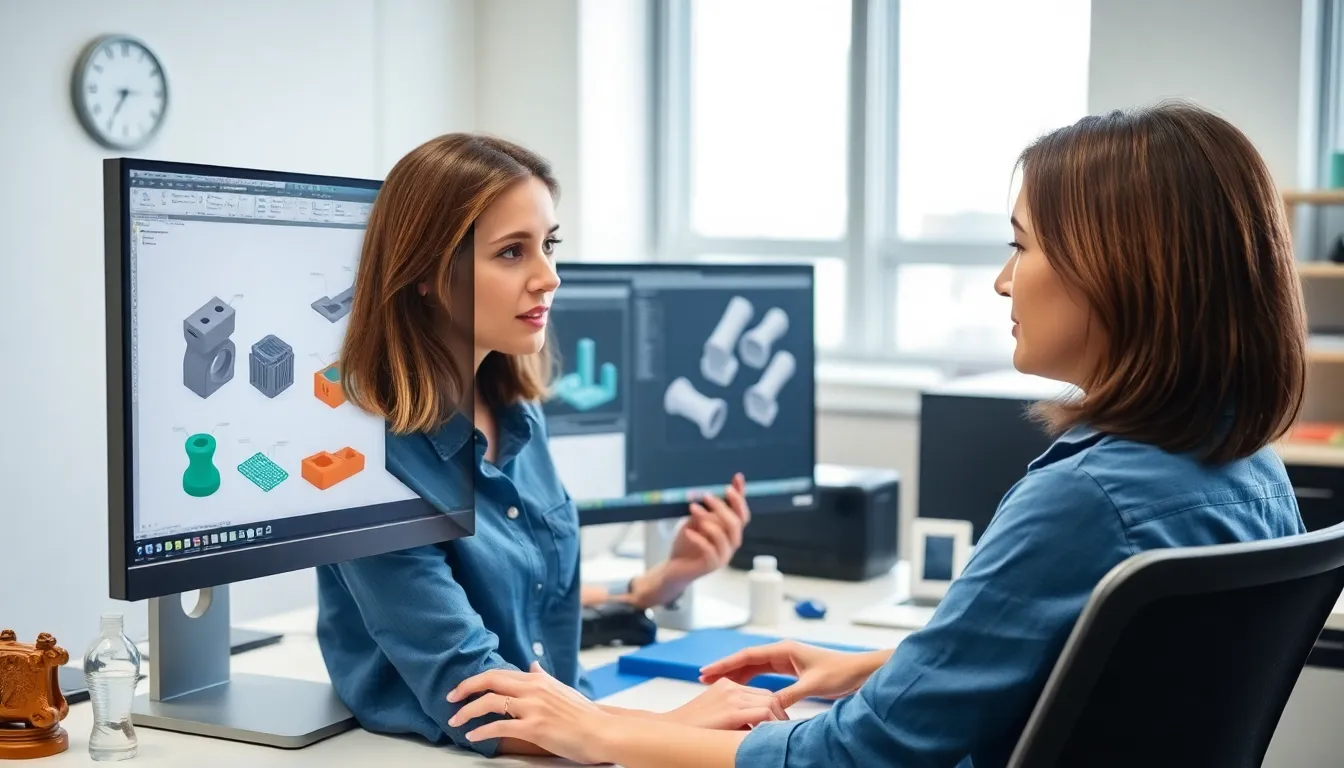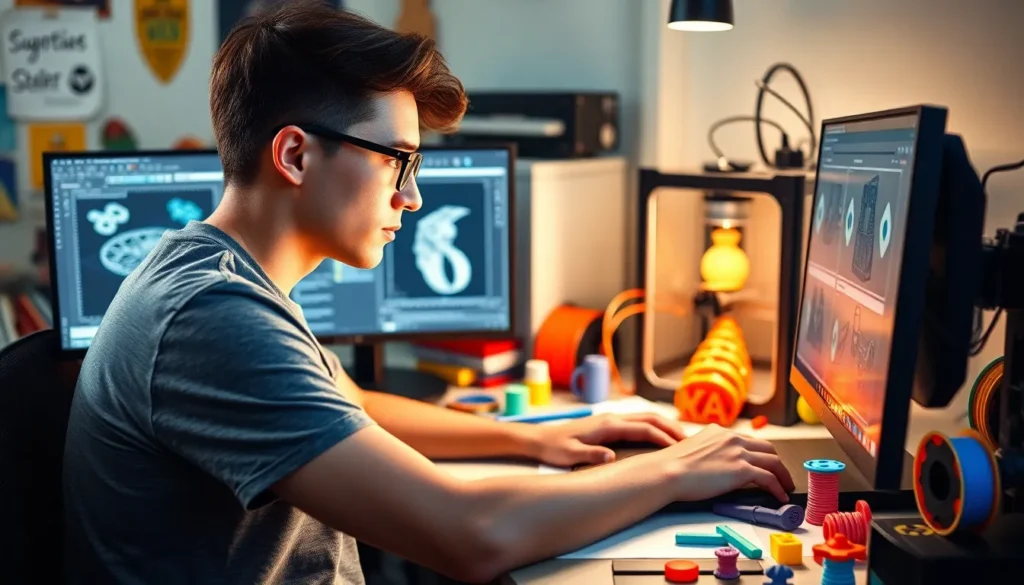Table of Contents
ToggleIn a world where creativity meets technology, AutoCAD 3D printing is the superhero we didn’t know we needed. Imagine transforming your wildest design dreams into tangible reality, all while sipping coffee in your pajamas. With AutoCAD’s powerful tools, designers can effortlessly create intricate 3D models that leap from the screen and into the physical realm.
Overview of AutoCAD 3D Printing
AutoCAD 3D printing enables designers to transform their concepts into tangible objects with precision. Creating detailed 3D models in AutoCAD is straightforward, catering to both beginners and experienced users. The software provides powerful tools for modeling, allowing for intricate designs that can be tailored to specific needs.
Configuring designs for 3D printing in AutoCAD involves setting dimensions and verifying model integrity. Users can inspect geometry through various viewing options, ensuring all elements are compatible with 3D printing requirements. Once finalized, files can be exported in formats such as STL, widely accepted by most 3D printers.
Integrating AutoCAD with 3D printing streamlines the design process. Designers can quickly iterate on concepts, making adjustments as needed without disrupting workflow. Direct control over design quality leads to enhanced accuracy and efficiency.
Cost-effective solutions arise from using AutoCAD for 3D printing. Savings on material and production time occur, especially when creating prototypes or small batch productions. Users appreciate these benefits, as they make the design-to-production cycle faster.
Collaboration is another advantage of AutoCAD 3D printing. Sharing models with team members or clients fosters feedback and accelerates development. Inputs from various stakeholders refine final products, ensuring higher satisfaction.
Ultimately, AutoCAD 3D printing revolutionizes how professionals approach design. Encouraging creativity and innovation, it plays a crucial role in fields such as architecture, engineering, and product design. Leveraging these capabilities, users turn imaginative ideas into reality with remarkable ease.
Benefits of Using AutoCAD for 3D Printing

AutoCAD offers numerous advantages for designers engaged in 3D printing. These benefits enhance the overall design process and improve productivity.
Enhanced Design Capabilities
AutoCAD provides advanced modeling features that empower designers to create intricate shapes and details. Users can manipulate objects with precision, ensuring every aspect of the design meets exact specifications. The variety of tools available allows for customization of elements such as textures and colors, resulting in visually appealing outcomes. Additionally, compatibility with different file formats lets designers work seamlessly with other CAD software. This flexibility supports iteration and experimentation, promoting creativity while ensuring technical accuracy.
Streamlined Workflow
Streamlined workflows emerge as a pivotal advantage when using AutoCAD for 3D printing. Designers experience improved efficiency through integrated design checks that prevent errors early in the process. Rapid adjustments can occur without interrupting the overall project trajectory, enhancing collaboration among team members. Automatic updates to models save time and minimize manual corrections. Furthermore, exporting models in formats compatible with 3D printers simplifies the transition from digital design to physical object. This efficiency not only accelerates project timelines but also boosts productivity for individuals and teams alike.
Getting Started with AutoCAD 3D Printing
AutoCAD enables users to dive into the world of 3D printing with ease. Understanding the necessary system requirements and fundamental features ensures a smooth start.
System Requirements
Operating AutoCAD for 3D printing demands certain specifications. Users must have a 64-bit Windows or macOS system for optimal performance. The application requires at least 8 GB of RAM, although 16 GB is preferable for handling complex models. A graphics card with DirectX 11 support enhances rendering of 3D designs. Disk space needs a minimum of 7 GB for installation, ensuring sufficient room for projects. Connectivity to 3D printers often involves USB or Wi-Fi, so options for these connections play a critical role.
Basic Tools and Features
Basic tools in AutoCAD unlock robust capabilities for 3D printing. The 3D modeling workspace presents options for creating complex geometries, such as solids and surfaces. Users can leverage commands like EXTRUDE, REVOLVE, and SWEEP to generate shapes from 2D sketches. Features for editing include FILLET and CHAMFER to refine model edges. Visual styles allow users to switch between wireframe and shaded views, facilitating better design inspection. Finally, exporting capabilities enable saving files in formats like STL or OBJ, essential for 3D printing compatibility.
Best Practices for AutoCAD 3D Printing
Effective AutoCAD 3D printing relies on proper techniques and file preparations. Consider the following best practices to achieve optimal results.
Model Optimization Techniques
Optimizing models enhances print quality and reduces material waste. Simplifying geometry helps eliminate unnecessary details while maintaining essential features. Applying uniform wall thickness ensures even printing and strength. Utilizing tools like mesh repair functions addresses any geometric errors, promoting model integrity. Furthermore, orienting models strategically can maximize the use of available space and minimize support requirements, resulting in efficient prints.
Preparing Files for Printing
Preparing files for 3D printing is crucial for successful outcomes. Exporting designs in STL format allows for compatibility with most slicing software. Checking the scale ensures the final product matches intended dimensions. Confirming the integrity of the model through inspection software identifies any issues before printing. Additionally, selecting the right resolution during the export process balances detail with file size, facilitating smoother slicing.
AutoCAD 3D printing stands as a game-changer for designers across various fields. By merging creativity with cutting-edge technology it empowers users to bring their ideas to life with unmatched precision. The software’s robust modeling tools and streamlined workflows not only enhance productivity but also foster collaboration and innovation.
With the ability to quickly iterate designs and optimize for print quality AutoCAD makes the 3D printing process accessible for both novices and seasoned professionals. As this technology continues to evolve it’s clear that AutoCAD 3D printing will play a pivotal role in shaping the future of design and manufacturing. Embracing these capabilities can lead to remarkable advancements in any project.




